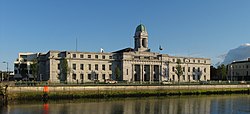| City Hall, Cork | |
|---|---|
Halla na Cathrach, Corcaigh | |
 Cork City Hall, as viewed from Lapp's Quay | |
 | |
| General information | |
| Address | Albert Quay |
| Town or city | Cork |
| Country | Ireland |
| Coordinates | 51°53′50″N8°27′55″W / 51.8971°N 8.4654°W |
| Construction started | 1932 |
| Completed | 1936 |
| Design and construction | |
| Architect(s) |
|
| Main contractor | John Sisk & Son |

The City Hall, Cork (Irish : Halla na Cathrach, Corcaigh) is a civic building in Cork, Ireland which houses the administrative headquarters of Cork City Council.